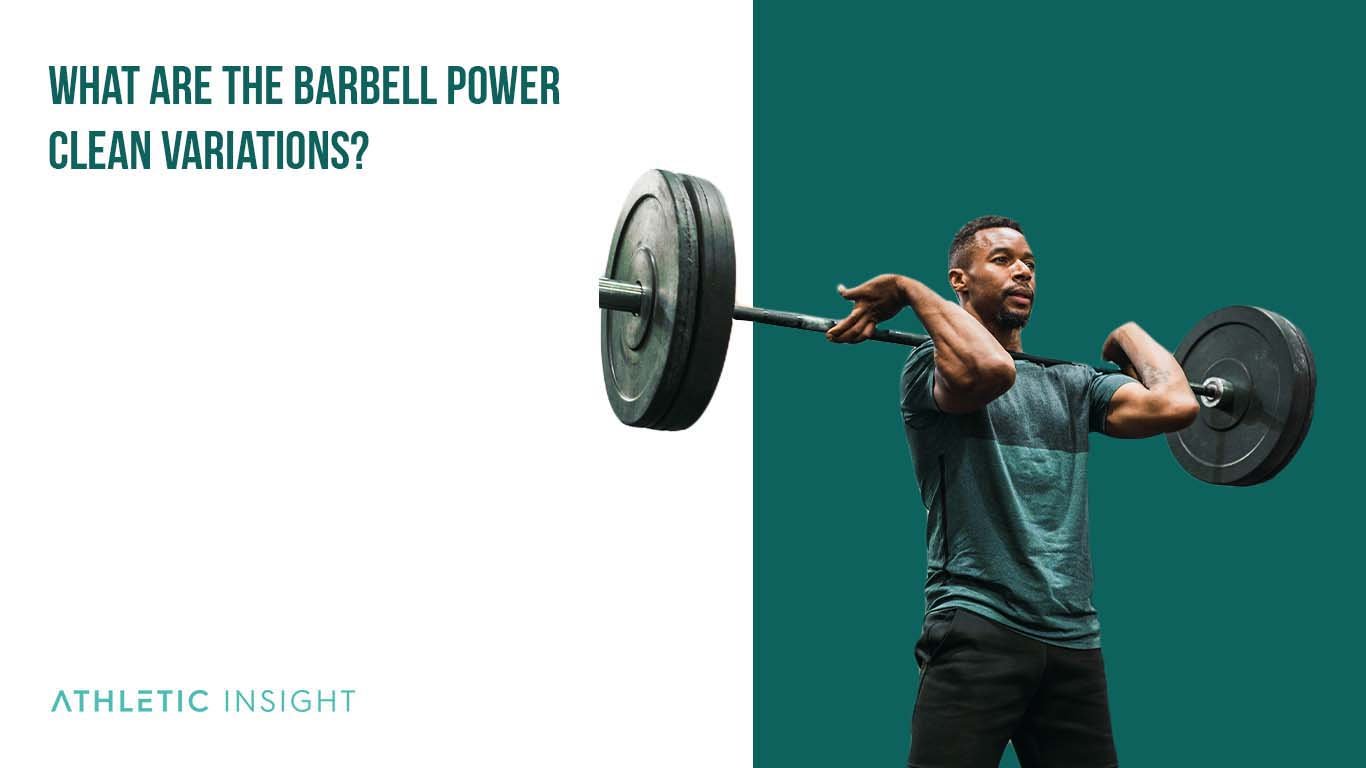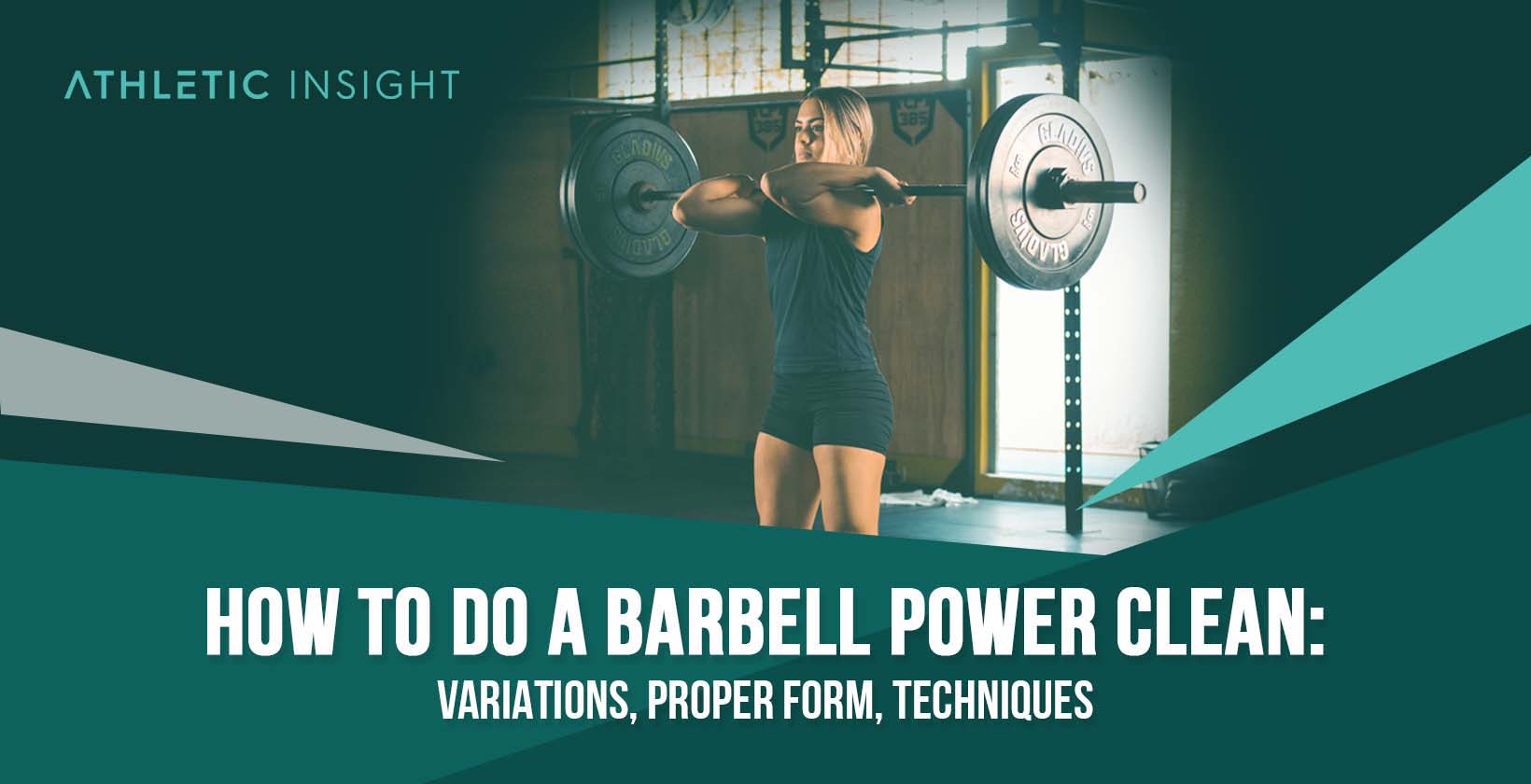The barbell power clean is an Olympic style, exercise movement that engages the whole body. The power clean involves squatting, gripping a barbell, and then lifting the barbell to shoulder height. This explosive exercise primarily works the posterior muscles and is a highly technical movement.
The movement builds strength in the calves, gluteal muscles, and hamstrings. Muscles in the arms, shoulders, back, and core also engage by holding and lifting the barbell. The barbell power clean also improves coordination and builds strength. The power clean enhances the muscles used for jumping, running, and lifting. Athletes primarily use this movement for strength-building, but it works well for toning and fat burning, too.
To perform a barbell power clean, the athlete must have a barbell of an appropriate weight for their training level. Athletes new to the power clean workout need to start at the lower end of the weight recommendations. Once the athlete chooses the barbell, the power clean is completed in six steps.
The first step is the setup where the athlete stands with the feet shoulder-width apart and squats to grip the bar. The second step is the pull, in which the athlete straightens the knees to stand and lift the bar. The third step is the transition scoop. The athlete drops back to lift the bar and get beneath it. The fourth step is the second pull, which is a shrug that lifts the barbell. The fifth step is the catch. The athlete straightens the knees to stand with the barbell held in place in front of their shoulders. The sixth and final step of the power cleans workout is the release. This step involves placing the barbell on the floor in a slow and controlled movement.
While this movement is beneficial in terms of building muscle and improving your fast twitch muscle reaction speeds, it is also dangerous. If you use an improper form such as starting in the wrong position or improperly lifting the bar, this may result in serious injuries to your muscles and joints.
How to Perform Barbell Power Clean With Proper Form?
To dominate barbell power clean movements, athletes must maintain proper form. The back should not curve or slump, the elbows should stay straight and unbent, and the body should be held tight at all times during the movement.
The following steps outline how to do a barbell power cleaning exercise with the proper form.
- Place the barbell at your feet and stand tall with the feet hip-distance apart.
- Squat and grab the bar with your hands facing your legs.
- Lengthen your spine to avoid feeling slumped over.
- Engage your core to support your back and midsection.
- Lift the bar as you stand up.
- Maintain the weight close to your body.
- Raise the bar till it touches your thighs.
- Prepare for the following swift motions and bend the knees slightly.
- Move the bar closer to the chest, push or “scoop” the hips forward with vigor.
- Elevate your shoulders as you pull the bar in the last stage of this movement.
- Pull your body beneath the bar as you raise it.
- Drop into a quarter squat, maintaining your back firm and your posture upright.
- Grasp the bar so that it rests on the front of your shoulders.
- Stand tall, with your weight evenly distributed across the front of your shoulders.
- Lower the weight to the floor slowly and deliberately.
A power cleaning exercise done with the proper form engages the leg muscles, posterior muscles, arm muscles, shoulders, and core to build strength. If the back curves, the elbows bend, or the movements are not controlled and tight, the muscles don’t benefit as much. Common injuries are more likely.
What Are the Phases of Barbell Power Clean?
The barbell power cleaning technique involves six phases or stages. Each is a separate movement that needs the proper form for best results.
The six phases of the power cleaning technique start with putting the barbell in the right place to grip it and end with putting the barbell on the floor and releasing it.
- Set-Up
- First Pull
- Transition Scoop
- Second Pull
- Catch
- Release
What Are the Mistakes for Barbell Power Clean Form?
Good barbell power clean form is crucial for building strength and avoiding strains and injury. Here are some of the most common barbell power clean Barbell power clean Mistakes.
- Starting with the barbell too far away.
- Bending the elbows is known as an arm pull.
- Leaning back with the barbell and opening the chest and hips too soon.
- Lifting the barbell too quickly.
- Beginners lift from the floor instead of a low block when they don’t have the flexibility to get into the proper set-up position.
These mistakes lead to common injuries like muscle pulls and strains.
Good barbell power clean form lets athletes complete their cleans lift without muscle strain or injury and properly engages the posterior muscles.
How to Determine Proper Weight for Barbell Power Clean?
The first step in learning how to do a power clean is to calculate the weight of the barbell. Standard recommendations are .7 to 1.4 times a female athlete’s body weight and 1 to 1.8 times a male athlete’s body weight.

What Is the Importance of Grip for Barbell Power Clean?
Athletes who learn how to do a clean will master the hook grip. They grasp the bar from above with the thumb between the tips of their fingers and the bar. This form provides maximum grip strength on the bar while rotating and lifting it during the catch.
The hands should be shoulder-width apart on the bar for stability.
Which Muscles are Involved while Performing Barbell Power Clean?
The barbell power clean exercise works the same muscles as the squat jump exercise without the impact. The power clean workout engages several muscles in the lower body.
- Hamstrings
- Gluteal muscles
- Calves
The deep squat in the set-up stretches the muscles in the thighs and hips. Using those muscles to stand and push up while lifting the barbell engages them and gives them most of the work. The power clean workout also engages upper body muscles.
- Abdominals
- Trapezius muscle
- Latissimus dorsi muscles
- Arm muscles
The movement of shrugging and getting beneath the barbell helps work the trapezius and latissimus dorsi muscles in the back. The abdominals engage with each movement, particularly the lift. The arm muscles benefit from bearing the weight of the barbell.
Unlike many exercises that focus only on the mirror muscles, this exercise increases overall strength by working the trapezius and latissimus dorsi muscles that affect posture and overall body form.
What Are the Barbell Power Clean Variations?
Two common barbell power clean variations and alternatives provide options for beginners getting used to the exercise and people who want to add another movement to the lift.

- No Weight for Beginners: This barbell power clean variation works the same as the standard exercise, but the beginner will lift the barbell without weight plates. Using no weight lets people learn the movements and the flow of the barbell power clean while focusing on form and increasing flexibility.
- Clean and Press: The clean and press exercise is one of the variations of barbell power clean that offers people practiced at the movement a new challenge. The clean and press variation builds the arm muscles and improves upper body strength. The exercise is done the same until the fifth stage. Instead of lowering the barbell to the floor, the athlete pushes the barbell into the air. This movement is the press. The next step is to lower the bar to the clavicle, or collarbone, before bending the knees to lower the bar to the floor.
What Is the Necessary Equipment for Barbell Power Clean?
Anyone wondering, “Is power clean safe?” should ensure they use the right equipment. The barbell power clean is a safe, strength-building exercise with the right gear. Here’s the equipment necessary for safe barbell power clean exercises.
- Barbell
- Weight plates
- Supportive shoes for support while pressing feet into the floor
- A low block or platform when the athlete can’t maintain proper form lifting the barbell from the floor.
The best power clean barbells are standard Olympic barbells that measure 7.2 feet long. The proper length lets the athlete grip the bar at the proper width for the best form.
What Are the Barbell Power Clean Related Facts?
Here are six reasons why the Barbell power clean is the best exercise
- Clean lifting builds an athlete’s power through fast movement.
- The posterior muscles engage the most during a power clean, but the movement builds full-body strength.
- Clean lifting builds endurance.
- This exercise burns calories and fat.
- Clean lifting promotes good posture by strengthening the posterior chain.
- The movement strengthens bones through calcification.
Clean lifting offers full-body exercise, strength-building, and improved posture instead of enhancing only one muscle group or part of the body.
Does Barbell Power Clean Affect the Hormones?
Yes, the barbell power clean does affect hormones. The power clean workout triggers the pituitary gland to release a small amount of growth hormone, which helps build muscle and increase bone density.
Does Barbell Power Clean Increase Testosterone?
Yes, the barbell power clean will increase testosterone. Testosterone is the male primary sex hormone. The hormone is also an anabolic steroid. Testosterone is responsible for male sexual development, including the genitals and secondary sex characteristics like muscle mass and hair growth.
The strain of the barbell power clean triggers the release of testosterone. The body releases the hormone to help the body repair and recover. What are power cleans good for? The barbell power clean increases testosterone.
Does Barbell Power Clean Affect the Mood?
Yes, power cleans affect the mood because they release endorphins. Endorphins are chemicals that improve mood by creating a positive feeling. These chemicals interact with the brain to dull pain and create a sense of euphoria.
Is Barbell Power Clean Practiced Within CrossFit?
Yes, the barbell power clean is practiced within CrossFit. The CrossFit definition is a philosophy of high-intensity exercise with varied movements. Calisthenics, weight lifting, gymnastics, and many other types of exercise fit within CrossFit workouts.
The power clean CrossFit technique works within CrossFit as part of the weight lifting portion of a workout. The movement replaces the squat clean for those who want to cycle faster through their lifts.
Is Barbell Power Clean a Military Movement?
No, the power clean exercise isn’t officially used in military exercises, though the movement is modified to become the military press in official workout regimes.
Is Barbell Power Clean Dangerous?
Yes, the barbell power clean can be dangerous with poor form or too much weight for the athlete. With proper technique and appropriate weight, the exercise is safe.
Is Barbell Power Clean Essential?
Yes, the proper power clean technique should be part of a weightlifting program. The exercise incorporates fundamental human movements like squatting, standing, and lifting. The intensity of the exercise enhances key muscles and promotes health and fitness.
Is Barbell Power Clean an Olympic Lift?
Yes, the power clean is one of the Olympic weightlifting movements with the squat clean, front squat, push jerk, power snatch, and squat snatch.



